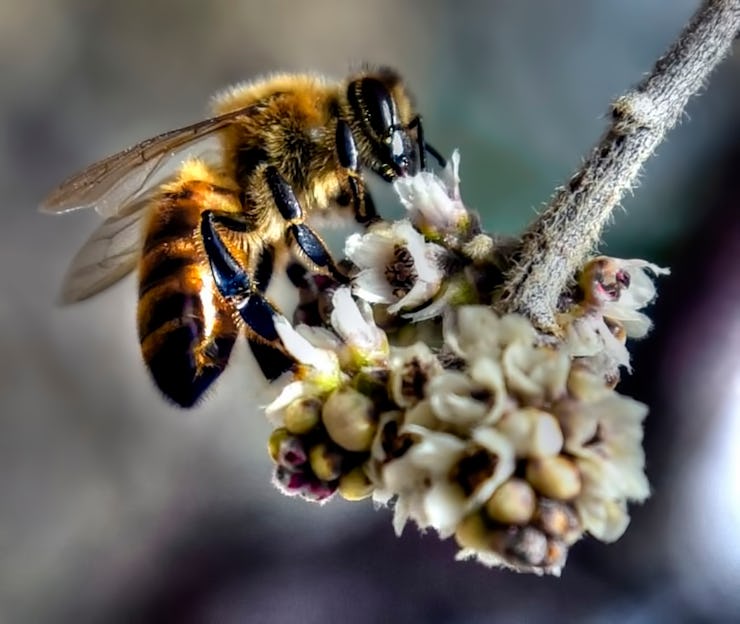Mad Honey: What to know before eating hallucinogenic honey from Nepal
Hint: It's not worth it.

Believe it or not, there’s a type of honey that will make you trip balls. In a handful of locations around the world ranging from Nepal to the Pacific Northwest, bees make a very special kind of honey. Often referred to as “Mad Honey,” the stuff looks different (it’s red, not yellow) and tastes bitter. But weirdest of all, it’s a powerful hallucinogen.
That’s right, hallucinogenic honey exists, but should you try it? Here’s what you need to know.
What is “mad honey”?
Mad honey is known to cause nausea, dizziness, and vomiting. Because of its unique look and taste (plus its rarity), it’s highly unlikely you’ll eat some by mistake. (That’s probably a good thing, but more on why in a bit.)
Unsurprisingly, some people seek out mad honey and pay a premium for it. As National Geographic reports, harvesters risk their lives to raid beehives for the honey. Devotees say it has medicinal benefits, claiming that it helps with arthritis and sexual performance, among other things.
Mad honey is made by bees that feed on rhododendron flowers, which give it its psychoactive effects. Rhododendrons, evergreen flowering plants that grow in temperate, mountainous areas around the world, contain chemicals called grayanotoxins.
Why does mad honey make you hallucinate?
Rhododendron flowers contain grayanotoxins, which make their way virtually unchanged through bees into their honey.
These neurotoxic compounds are cyclic diterpenes that exist in varying concentrations and varieties, depending on the particular rhododendron species and the time of year. Scientists have identified more than 25 types of grayanotoxins in rhododendrons. These chemicals make their way into the honey of bees that are feeding primarily on rhododendrons during the late spring, when so many of the plants are flowering that the bees can feast solely on rhododendron flowers without foraging elsewhere. In fact, some Turkish beekeepers even place their bee hives near rhododendron groves so that the bees will forage there, according to Modern Farmer.
Grayanotoxins, whether consumed in mad honey or in any part of the rhododendron, work in the human body by binding to voltage-gated sodium ion channels in cells. This keeps the channels from closing quickly, explains forensic toxicologist Justin Brower in his blog, Nature’s Poisons]
“The result is a state of depolarization in which sodium ions are freely flowing into the cells, and calcium influx is on the rise. The increase in calcium stimulates the release of acetylcholine,” he writes. This acetylcholine excess causes what’s known as a cholinergic syndrome, which results in a set of symptoms known by their toxicology acronym, SLUDGE: Salivation, Lacrimation (crying), Urination, Defecation, Gastrointestinal distress, and Emesis (vomiting). In low to moderate doses, it’s known to cause heart rate and blood pressure to drop, and in high enough doses it can theoretically kill you, though there seem to be few reported cases of death from mad honey.
Grayanotoxins function on voltage-gated sodium ion channels, causing them to get depolarized. This can, in turn, result in a cholinergic syndrome characterized by the acronym SLUDGE: Salivation, Lacrimation (crying), Urination, Defecation, Gastrointestinal distress, and Emesis (vomiting).
Like other traditional medicines, the rationale behind mad honey is as mythical as it is scientific. There’s a story that the army of the Persian King Mithridates defeated its Roman foes by littering the road with enticing mad honey honeycombs. According to this millennia-old story, the invading troops ate the honey and were easily defeated while under the influence of its intoxicating effects.
What to know before taking Mad Honey
Experienced users know that a small amount is all that’s needed, especially since a substance like mad honey possesses its toxins in unknown concentrations. Others, like members of the message boards of Erowid, a community notorious for experimentation, strongly recommend against consuming rhododendron components.
It’s not just intoxication that people seek from it, though. As stated before, many people claim that mad honey offers relief from arthritis and helps enhance sexual performance. Like many traditional medicines, there isn’t a wealth of experimental data or clinical trials to back up these claims, but in recent years there is some evidence to suggest that they’re not too farfetched.
Researchers have found some evidence that suggests that grayanotoxin-containing preparations could help with hypertension, diabetes, high cholesterol, and even cold sores. These are just preliminary studies, though, and as such should not be taken as evidence that mad honey is safe or effective.
Medical remedies aside, if you’re searching for that next great high, mad honey is probably not the best place to look. Perhaps we can suggest something a bit more reliable.